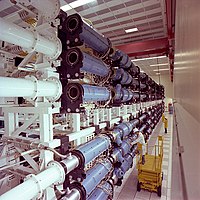Big science

Big Science refers to large-scale scientific research projects that require a lot of funding, resources, and collaboration from many scientists and researchers around the world.
Think of it like building a huge LEGO set. You need a lot of LEGO pieces, maybe even thousands, and you have to work with other people to put it together properly. Big Science projects are similar in that they require many scientists to work together to achieve a common goal or answer a big scientific question.
For example, CERN, which stands for Conseil Européen pour la Recherche Nucléaire, is a large scientific organization that is currently working on understanding the fundamental properties of the universe by colliding particles together in their Large Hadron Collider. This is a huge project that involves scientists from all over the world, lots of funding, and complex technology.
Similarly, NASA's exploration of space is another example of Big Science. NASA sends satellites and probes out into space to explore other planets and galaxies, and this requires a lot of money and advanced technology.
Overall, Big Science allows scientists to perform research beyond what could be done by individuals or small teams. By pooling resources and knowledge, these large-scale projects can help us better understand the world around us and the universe we live in.
Think of it like building a huge LEGO set. You need a lot of LEGO pieces, maybe even thousands, and you have to work with other people to put it together properly. Big Science projects are similar in that they require many scientists to work together to achieve a common goal or answer a big scientific question.
For example, CERN, which stands for Conseil Européen pour la Recherche Nucléaire, is a large scientific organization that is currently working on understanding the fundamental properties of the universe by colliding particles together in their Large Hadron Collider. This is a huge project that involves scientists from all over the world, lots of funding, and complex technology.
Similarly, NASA's exploration of space is another example of Big Science. NASA sends satellites and probes out into space to explore other planets and galaxies, and this requires a lot of money and advanced technology.
Overall, Big Science allows scientists to perform research beyond what could be done by individuals or small teams. By pooling resources and knowledge, these large-scale projects can help us better understand the world around us and the universe we live in.
